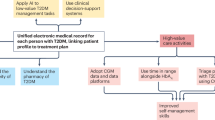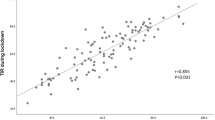Abstract
Purpose of Review
Continuous glucose monitoring (CGM) technology has long been accepted as a tool for managing glycemia in type 1 diabetes (T1D) and is receiving increased attention as a tool for monitoring glucose patterns in patients with other forms of diabetes, in particular type 2 diabetes (T2D). Recent studies in adults with T2D have shown benefits of CGM in the investigation of glycemic variability, as well as utility as a tool for improving glycemic control. The literature on CGM use in youth-onset T2D, however, is sparse. This paper reviews the various roles for CGM in T2D, with a focus on published reports of CGM use in youth-onset T2D. The gaps in knowledge are highlighted, along with a discussion regarding need for future studies of potential applications for CGM in this younger population.
Recent Findings
CGM systems provide insight into glycemic abnormalities in obese youth with and at risk for T2D. This technology has enabled examination of the relationship between free-living glycemic profiles and traditional diabetes screening tests, as well as markers of cardiometabolic risk in this high-risk population.
Summary
Investigators are incorporating CGM technology into the study of T2D in youth, but interventional studies of CGM as a tool for glycemic control in youth-onset T2D are limited. Youth with T2D face a more aggressive disease than adults with T2D, and further studies utilizing advances in glucose monitoring technology to improve outcomes in this population are needed.
Similar content being viewed by others
References
Papers of particular interest, published recently, have been highlighted as: • Of importance
Juvenile Diabetes Research Foundation Continuous Glucose Monitoring Study G, Tamborlane WV, Beck RW, Bode BW, Buckingham B, Chase HP, et al. Continuous glucose monitoring and intensive treatment of type 1 diabetes. N Engl J Med. 2008;359(14):1464–76.
Juvenile Diabetes Research Foundation Continuous Glucose Monitoring Study G, Beck RW, Hirsch IB, Laffel L, Tamborlane WV, Bode BW, et al. The effect of continuous glucose monitoring in well-controlled type 1 diabetes. Diabetes Care. 2009;32(8):1378–83.
Deiss D, Bolinder J, Riveline JP, Battelino T, Bosi E, Tubiana-Rufi N, et al. Improved glycemic control in poorly controlled patients with type 1 diabetes using real-time continuous glucose monitoring. Diabetes Care. 2006;29(12):2730–2.
Fonseca VA, Grunberger G, Anhalt H, Bailey TS, Blevins T, Garg SK, et al. Continuous glucose monitoring: a consensus conference of the American Association of Clinical Endocrinologists and American College of Endocrinology. Endocr Pract. 2016;22(8):1008–21.
Peters AL, Ahmann AJ, Battelino T, Evert A, Hirsch IB, Murad MH, et al. Diabetes technology—continuous subcutaneous insulin infusion therapy and continuous glucose monitoring in adults: an Endocrine Society clinical practice guideline. J Clin Endocrinol Metab. 2016;101(11):3922–37.
• Vigersky R, Shrivastav M. Role of continuous glucose monitoring for type 2 in diabetes management and research. J Diabetes Complicat. 2017;31(1):280–7. This review provides a thorough overview of published studies involving CGM in adults with T2D
Allen NA, Fain JA, Braun B, Chipkin SR. Continuous glucose monitoring in non-insulin-using individuals with type 2 diabetes: acceptability, feasibility, and teaching opportunities. Diabetes Technol Ther. 2009;11(3):151–8.
Allen NA, Fain JA, Braun B, Chipkin SR. Continuous glucose monitoring counseling improves physical activity behaviors of individuals with type 2 diabetes: a randomized clinical trial. Diabetes Res Clin Pract. 2008;80(3):371–9.
Bailey TS, Zisser HC, Garg SK. Reduction in hemoglobin A1C with real-time continuous glucose monitoring: results from a 12-week observational study. Diabetes Technol Ther. 2007;9(3):203–10.
Gehlaut RR, Dogbey GY, Schwartz FL, Marling CR, Shubrook JH. Hypoglycemia in type 2 diabetes—more common than you think: a continuous glucose monitoring study. J Diabetes Sci Technol. 2015;9(5):999–1005.
Kim SK, Kim HJ, Kim T, Hur KY, Kim SW, Lee MK, et al. Effectiveness of 3-day continuous glucose monitoring for improving glucose control in type 2 diabetic patients in clinical practice. Diabetes Metab J. 2014;38(6):449–55.
Munshi MN, Segal AR, Suhl E, Staum E, Desrochers L, Sternthal A, et al. Frequent hypoglycemia among elderly patients with poor glycemic control. Arch Intern Med. 2011;171(4):362–4.
Chico A, Vidal-Rios P, Subira M, Novials A. The continuous glucose monitoring system is useful for detecting unrecognized hypoglycemias in patients with type 1 and type 2 diabetes but is not better than frequent capillary glucose measurements for improving metabolic control. Diabetes Care. 2003;26(4):1153–7.
Marfella R, Barbieri M, Grella R, Rizzo MR, Nicoletti GF, Paolisso G. Effects of vildagliptin twice daily vs. sitagliptin once daily on 24-hour acute glucose fluctuations. J Diabetes Complicat. 2010;24(2):79–83.
Koyanagawa N, Miyoshi H, Ono K, Nakamura A, Cho KY, Yamamoto K, et al. Comparative effects of vildagliptin and sitagliptin determined by continuous glucose monitoring in patients with type 2 diabetes mellitus. Endocr J. 2016;63(8):747–53.
Vigersky RA, Fonda SJ, Chellappa M, Walker MS, Ehrhardt NM. Short- and long-term effects of real-time continuous glucose monitoring in patients with type 2 diabetes. Diabetes Care. 2012;35(1):32–8.
Fonda SJ, Salkind SJ, Walker MS, Chellappa M, Ehrhardt N, Vigersky RA. Heterogeneity of responses to real-time continuous glucose monitoring (RT-CGM) in patients with type 2 diabetes and its implications for application. Diabetes Care. 2013;36(4):786–92.
Mohan V, Jain S, Kesavadev J, Chawla M, Mutha A, Viswanathan V, et al. Use of retrospective continuous glucose monitoring for optimizing management of type 2 diabetes in India. J Assoc Physicians India. 2016;64(4):16–21.
Leinung M, Nardacci E, Patel N, Bettadahalli S, Paika K, Thompson S. Benefits of short-term professional continuous glucose monitoring in clinical practice. Diabetes Technol Ther. 2013;15(9):744–7.
Pepper GM, Steinsapir J, Reynolds K. Effect of short-term iPRO continuous glucose monitoring on hemoglobin A1c levels in clinical practice. Diabetes Technol Ther. 2012;14(8):654–7.
Farabi SS, Carley DW, Smith D, Quinn L. Impact of exercise on diurnal and nocturnal markers of glycaemic variability and oxidative stress in obese individuals with type 2 diabetes or impaired glucose tolerance. Diab Vasc Dis Res. 2015;12(5):381–5.
Monnier L, Mas E, Ginet C, Michel F, Villon L, Cristol JP, et al. Activation of oxidative stress by acute glucose fluctuations compared with sustained chronic hyperglycemia in patients with type 2 diabetes. JAMA. 2006;295(14):1681–7.
Yamamoto C, Miyoshi H, Fujiwara Y, Kameda R, Ichiyama M, Nomoto H, et al. Degludec is superior to glargine in terms of daily glycemic variability in people with type 1 diabetes mellitus. Endocr J. 2016;63(1):53–60.
D'Adamo E, Caprio S. Type 2 diabetes in youth: epidemiology and pathophysiology. Diabetes Care. 2011;34(Suppl 2):S161–5.
Group TS, Zeitler P, Hirst K, Pyle L, Linder B, Copeland K, et al. A clinical trial to maintain glycemic control in youth with type 2 diabetes. N Engl J Med. 2012;366(24):2247–56.
Nadeau KJ, Anderson BJ, Berg EG, Chiang JL, Chou H, Copeland KC, et al. Youth-onset type 2 diabetes consensus report: current status, challenges, and priorities. Diabetes Care. 2016;39(9):1635–42.
Narasimhan S, Weinstock RS. Youth-onset type 2 diabetes mellitus: lessons learned from the TODAY study. Mayo Clin Proc. 2014;89(6):806–16.
Tryggestad JB, Willi SM. Complications and comorbidities of T2DM in adolescents: findings from the TODAY clinical trial. J Diabetes Complicat. 2015;29(2):307–12.
Copeland KC, Zeitler P, Geffner M, Guandalini C, Higgins J, Hirst K, et al. Characteristics of adolescents and youth with recent-onset type 2 diabetes: the TODAY cohort at baseline. J Clin Endocrinol Metab. 2011;96(1):159–67.
Boland EA, Tamborlane WV. Continuous glucose monitoring in youth with type 2 diabetes: overcoming barriers to successful treatment. Diabetes Technol Ther. 2000;2(Suppl 1):S53–9.
Pickup JC, Freeman SC, Sutton AJ. Glycaemic control in type 1 diabetes during real time continuous glucose monitoring compared with self monitoring of blood glucose: meta-analysis of randomised controlled trials using individual patient data. BMJ. 2011;343:d3805.
de Bock M, Cooper M, Retterath A, Nicholas J, Ly T, Jones T, et al. Continuous glucose monitoring adherence: lessons from a clinical trial to predict outpatient behavior. J Diabetes Sci Technol. 2016;10(3):627–32.
Allen NA. Continuous glucose monitoring improved glucose control in adults but not in young adults or children with type 1 diabetes. Evid Based Nurs. 2009;12(2):44.
Wong JC, Foster NC, Maahs DM, Raghinaru D, Bergenstal RM, Ahmann AJ, et al. Real-time continuous glucose monitoring among participants in the T1D exchange clinic registry. Diabetes Care. 2014;37(10):2702–9.
Anhalt H. Limitations of continuous glucose monitor usage. Diabetes Technol Ther. 2016;18(3):115–7.
Badaru A, Klingensmith GJ, Dabelea D, Mayer-Davis EJ, Dolan L, Lawrence JM, et al. Correlates of treatment patterns among youth with type 2 diabetes. Diabetes Care. 2014;37(1):64–72.
Lu H, Castells S, Hagerty D, Quintos JB. Study of glucose profiles with continuous glucose monitoring in adolescents with poorly controlled type 2 diabetes mellitus. J Pediatr Endocrinol Metab. 2008;21(8):729–36.
• Chan CL, Pyle L, Newnes L, Nadeau KJ, Zeitler PS, Kelsey MM. Continuous glucose monitoring and its relationship to hemoglobin A1c and oral glucose tolerance testing in obese and prediabetic youth. J Clin Endocrinol Metab. 2015;100(3):902–10. This study is the largest to date investigating CGM in obese and prediabetic youth and uses CGM to highlight important differences in interpretation of traditional screening tests for T2D
Dasari PS, Gandomani BS, Teague AM, Pitale A, Otto M, Short KR. Glycemic variability is associated with markers of vascular stress in adolescents. J Pediatr. 2016.
Rijks J, Karnebeek K, van Dijk JW, Dorenbos E, Gerver WJ, Stouthart P, et al. Glycaemic profiles of children with overweight and obesity in free-living conditions in association with cardiometabolic risk. Sci Rep. 2016;6:31892.
Chan CL, Pyle L, Kelsey MM, Newnes L, Baumgartner A, Zeitler PS, et al. Alternate glycemic markers reflect glycemic variability in continuous glucose monitoring in youth with prediabetes and type 2 diabetes. Pediatr Diabetes. 2016.
Chan CL, Pyle L, Morehead R, Baumgartner A, Cree-Green M, Nadeau KJ. The role of glycemia in insulin resistance in youth with type 1 and type 2 diabetes. Pediatr Diabetes. 2016.
Author information
Authors and Affiliations
Corresponding author
Ethics declarations
Conflict of Interest
Christine L. Chan declares that she has no conflicts of interest.
Human and Animal Rights and Informed Consent
This article does not contain any studies with human or animal subjects performed by any of the authors.
Additional information
This article is part of the Topical Collection on Pediatric Type 2 and Monogenic Diabetes
Rights and permissions
About this article
Cite this article
Chan, C.L. Use of Continuous Glucose Monitoring in Youth-Onset Type 2 Diabetes. Curr Diab Rep 17, 66 (2017). https://doi.org/10.1007/s11892-017-0905-0
Published:
DOI: https://doi.org/10.1007/s11892-017-0905-0




